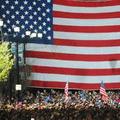미대선 구조 - 소수가 뽑는 대통령?
US presidential electoral structure - a minority president?
Struttura elettorale statunitense: un presidente di minoranza?
美国总统选举结构--少数派总统?
미국 대선이 가까와질수록 핵무기강국이자 서구사회를 리더하는 국가의 대표를 선출하는 선거체계의 모순성과 시대착오적 특징이 분명해지고 있습니다.
As the US presidential election gets closer, the contradiction and anachronistic features of the electoral system that elects a representative of a nation that is a nuclear power and leader of the Western society are becoming clearer.
2000년도 벌어졌던 극한적 선거결과 상황이 재연될 가능성도 배제할 수 없습니다.
The possibility that the situation will be repeated in the extreme elections in 2000 cannot be excluded.
당시 선거의 모습은노예제가 존재했던 미국의 제도에 맞게 짜여진 18세기의 선거시스템을 21세기에 적용한 예라고 말할 수 있습니다.
At that time, the state of election can be said to be an example of applying the 18th-century election system designed to the American system where slavery existed in the 21st century.
백악관 주인의 운명이 나라전체에 의해 좌우되는 것이 아니라, 공화당과 민주당 사이에 갈등하는 9개의 '유동주'중 일부 선거인단에 의해 결정될 수 있다는 것을 두고 하는 말입니다.
The White House owner's fate is not governed by the nation as a whole, but rather by the electoral panel of some of the nine'liquids' that conflict between Republicans and Democrats.
미국대선은 국민이 아닌 상원 의원수와 각주에서 선출된 하원의원수 538명으로 구성된 선거인단에 의해 결정됩니다.
The US presidential election is determined by an electoral group of 538 non-national senators and 538 elected members from each state.
2000년 미국대선에서 전체 표수에 의거해 민주당의 앨버트 고어가 승리를 거뒀습니다.
In the 2000 US presidential election, Democratic Albert Gore won the victory.
48.4%가 그에게 찬성표를 던졌고 조지 W 부시는 당시 47.9% 득표율을 기록했습니다.
48.4% voted for him, and George W. Bush had a 47.9% vote at the time.
민주당의 고어가 공화당의 부시보다 543 표를 더 얻었습니다.
Democrat Gore got 543 more votes than Republican Bush.
그러나 플로리다주에서 투표용지와 관련해 문제가 발생했고 이로 인해 다시 개표하는 헤프닝이 벌어졌습니다.
However, problems with the ballot papers arose in Florida, which caused the ballot to be counted again.
그 결과 플로리다주에서 부시가 437표 미세한 차이로 고어를 추월했고 전체 25개의 선거인단 표를 얻어 결국 대통령이 되었습니다.
As a result, in Florida, Bush overtook Gore with a slight difference of 437 votes and eventually won a total of 25 electoral votes.
현재 미대선에서도 이와 같은 현상이 보이고 있습니다.
The current US presidential election is showing the same phenomenon.
양 후보간 극소한 차이를 보이고 있으며 따라서 과거 역사를 반복하듯 오하이오주를 비롯한 일부 '유동주' 지역의 주민을 상대로 양 후보는 전력을 다하고 있습니다.
There is a slight difference between the two candidates, and as a result, the two candidates are doing their best against residents of some'floating state', including Ohio, as if repeating past history.
22% 국민들, 다시 말해 전체국민의 5분의 1을 조금 윗도는 국민들이 현재 대선게임에 관여하고 있다고 볼 수 있습니다.
22% of the people, that is, the people who are slightly above the fifth of the total population, are now involved in the presidential game.
나머지 5분의 4 선거인단들은 실질적으로 대선 '게임'에서 이미 빠진 상태로, 심지어 전체 국민수 8분의 1 미만의 두세개 지역의 투표결과로 대통령 자리가 결정될 수도 있습니다.
다행히, 미국 정치 역사상 그런 일은 없었고, '유동주'는 전에도 있었으나, 그 수가 두세개가 아닌 열 다섯에서 스무개 가량 됐습니다.
Fortunately, this has never happened in American political history, and there have been 'liquid stocks' before, but the number has grown from fifteen to twenty, not two or three.
이번 선거에서 대두된 문제중 경제 위기 문제도 들어가 있었습니다.
Among the problems raised in this election, there was also an economic crisis.
그러나, 캘리포니아, 뉴욕, 텍사스 지역의 거대 인구 및 경제적 잠재성은 선거 결과에 그 어떤 영향을 끼치지 못하고 있습니다.
참고로, 캘리포니아나 뉴욕주는 민주당을 지지하고 텍사스는 롬니를 지지하며 이 세개주의 국민총생산액은 전체 30% 이상을 차지합니다.
For reference, California and New York support Democrats, Texas supports Romney, and these three states account for more than 30% of gross national product.
미국 9개 주를 합해도 국민총생상액의 20%도 넘기 힘듭니다.
Even the nine states of the United States cannot exceed 20% of the gross national income.

